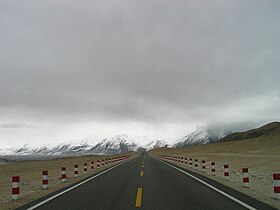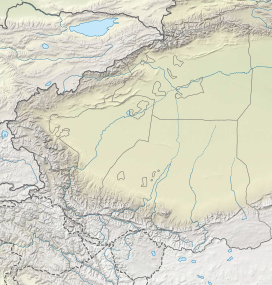Khunjerab Pass
| Khunjerab Pass | |
|---|---|
 Khunjerab Pass | |
| Elevation | 4,693 m (15,397 ft) |
| Traversed by | |
| Location | Hunza-15801, Pakistan - administered Gilgit–Baltistan / Xinjiang, China |
| Range | Karakoram Range |
| Coordinates | 36°51′00″N 75°25′42″E / 36.85°N 75.4283°E |
 | |
| Khunjerab Pass | |||||||
|---|---|---|---|---|---|---|---|
| Chinese name | |||||||
| Traditional Chinese | 紅其拉甫山口 | ||||||
| Simplified Chinese | 红其拉甫山口 | ||||||
| |||||||
Khunjerab Pass (Chinese: 红其拉甫口岸; Urdu: درہ خنجراب ⓘ; Uyghur: قونجىراپ ئېغىزى) is a mountain pass in northern Pakistan that lies at an elevation of 4,693 metres (15,397 ft) above sea level. It is located in the Karakoram and holds a significant strategic position on the northern border of Pakistan, specifically in the Gilgit-Baltistan's Hunza and Nagar Districts. Additionally, it is positioned on the southwestern border of China, within the Xinjiang region.
Near Khunjerab Pass, there is another pass known as Mutsjliga Pass, which stands at an elevation of 5,314 metres (17,434 ft) and is located at approximately 36°58′25″N 75°17′50″E / 36.97374°N 75.2973°E.
Etymology
[edit]The word "خنجراب" in the local Wakhi language means 'waterfall house'. It is derived from two words, "خون"-"Khun" means house and "جراب"-"Jerab" means a creek coming from a spring or a waterfall.
Notability
[edit]
The Khunjerab Pass holds several distinctions, including being the highest paved international border crossing globally and serving as the highest point along the Karakoram Highway. The construction of the road across this pass was completed in 1982, and it has since supplanted the previously unpaved Mintaka and Kilik passes as the principal route across the formidable Karakoram Range.
The decision to use the Khunjerab Pass for the Karakoram Highway was made in 1966. China citing the fact that Mintaka would be more susceptible to air strikes, recommended the steeper Khunjerab Pass instead.[1]
On the Pakistani-administered side, the pass is 42 km (26 mi) from the National Park station and checkpoint in Dih, 75 km (47 mi) from the customs and immigration post in Sost, 270 km (170 mi) from Gilgit, and 870 km (540 mi) from Islamabad.
On the Chinese side, the pass is the southwest terminus of China National Highway 314 (G314) and is 130 km (81 mi) from Tashkurgan, 420 km (260 mi) from Kashgar and 1,890 km (1,170 mi) from Urumqi. The Chinese port of entry is located 3.5 km (2.2 mi) along the road from the pass in Tashkurgan County.
The long, relatively flat pass is often snow-covered[2] during the winter season and as a consequence is generally closed for heavy vehicles from November 30 to May 1 and for all vehicles from December 30 to April 1.[3] This is not set however, late snowfall in the region attributed to climate-change means the road is accessible even during the winter months. Depending on the amount of snowfall, the road is cleared from time periods ranging from days to weeks.
Since June 1, 2006, there has been a daily bus service across the boundary from Gilgit to Kashgar, Xinjiang.[4]

This is one of the international borders where left-hand traffic (Pakistan-administered Gilgit-Baltistan) changes to right-hand traffic (China) and vice versa.
Highest ATM in the world
[edit]The Pakistani side features the highest ATM in the world, administered by the National Bank of Pakistan and linked to China UnionPay and the domestic 1LINK switch.[5]
Railway
[edit]In 2007, consultants[6] were hired to evaluate the construction of a railway through this pass to connect China with transport in Pakistan's Gilgit-Baltistan. A feasibility study started in November 2009 for a line connecting Havelian 750 km (466 mi), away Khyber Pakhtunkhwa, and Kashgar 350 km (217 mi) away in Xinjiang.[7] However, no progress has been made thereafter and this project is also not part of the current CPEC plan.
Gallery
[edit]-
Khunjerab Pass, border crossing between China and Pakistan
-
Khunjerab Pass Road
-
Chinese and Pakistani soldiers at Khunjerab Pass
-
China–Pakistan friendship monument in Attabad, about 150 km from the border
See also
[edit]- China–Pakistan border
- Mustagh Pass
- Sost
- Khunjerab National Park
- Karakoram Highway
- Gilgit–Baltistan
- Nathu La
- Abra del Acay
References
[edit]Citations
[edit]- ^ 刘欣 (3 May 2013). "重寻玄奘之路" [Rediscover the path taken by Xuanzang] (in Chinese). 东方早报. Retrieved 2 February 2017.
1966年,时任新疆军区副司令员的张希钦在主持修筑中巴公路时,为避敌国空袭,放弃了巴方主张的走宽阔的明铁盖达坂的方案,而取道地势高峻的红其拉甫山口。
[In 1966, when Zhang Xiqin, then deputy commander of the Xinjiang Military Region, was presiding over the construction of the China-Pakistan Highway, in order to avoid enemy air attacks, he gave up the plan advocated by Pakistan to take the wide Mingtie Gaida Ban, and instead took the high-terrain Khunjela. Fushankou.] - ^ "Snowfall at Khunjerab Pass, Gilgit-Baltistan - Travel and Tourism". Archived from the original on 7 August 2016. Retrieved 11 June 2016.
- ^ "Khunjerab Pass". www.dangerousroads.org. Retrieved 18 September 2016.
- ^ "Road widening work has begun on 600 km (370 mi) of the highway". www.dawn.com. Archived from the original on 22 June 2011.
- ^ "World's Highest ATM". Atlas Obscura (www.atlasobscura.com). Retrieved 26 July 2019.
- ^ Syed Fazl-e-Haider (24 February 2007). "China-Pakistan rail link on horizon". Online Asia Times, South Asia. Archived from the original on 26 February 2007. Retrieved 18 December 2023.
- ^ "Maps, Weather, Videos, and Airports for Kashi, China". www.fallingrain.com. Retrieved 18 December 2023.
Sources
[edit]- Curzon, George Nathaniel. 1896. The Pamirs and the Source of the Oxus. Royal Geographical Society, London. Reprint: Elibron Classics Series, Adamant Media Corporation. 2005. ISBN 1-4021-5983-8 (pbk); ISBN 1-4021-3090-2 (hbk).
- King, John 1989. Karakoram Highway : the high road to China. Hawthorn, Victoria, Lonely Planet Publications. ISBN 0-86442-065-X
- Episode 13/30 of the NHK television series The Silk Road, a series originally shown in Japan in the early 1980s.
External links
[edit] Media related to Khunjerab Pass at Wikimedia Commons
Media related to Khunjerab Pass at Wikimedia Commons






